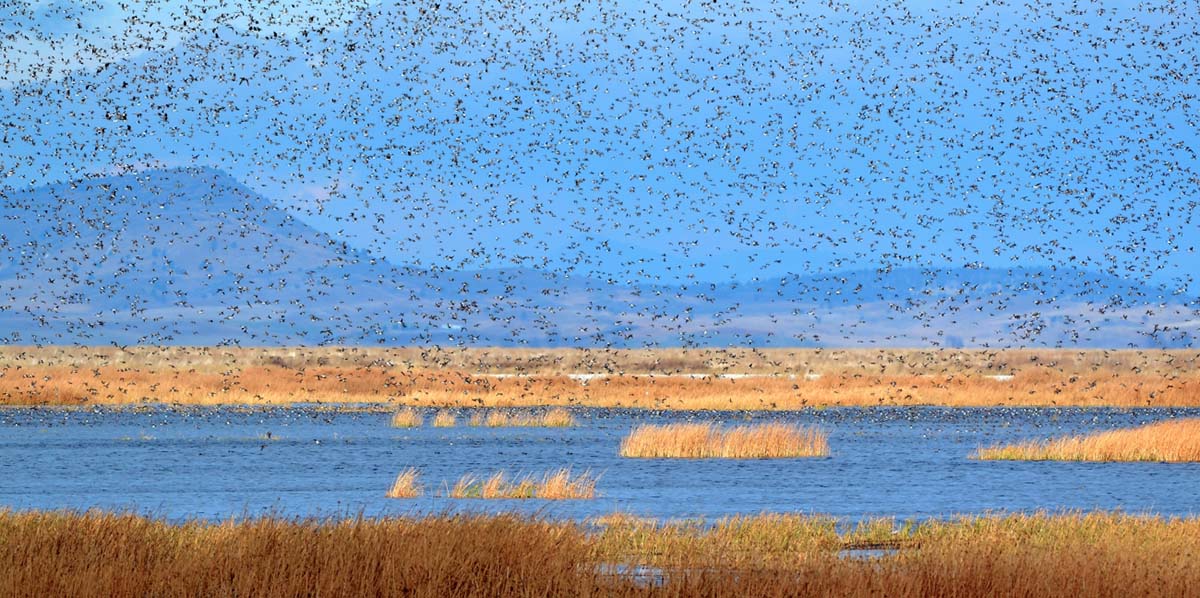Klamath Basin Refuges Flooded for First Time Since 2020
Water from the Klamath River was delivered to Lower Klamath and Tule Lake NWRs
Water from the Klamath River was delivered to Lower Klamath and Tule Lake NWRs

In March, over 20,000 acre-feet of much-needed water was delivered to Lower Klamath and Tule Lake National Wildlife Refuges (NWR). Ducks Unlimited (DU) partnered with the Tulelake Irrigation District (TID) and the U.S. Fish and Wildlife Service to activate Pumping Plant D for the first time in four years to help flood wetlands that have been dry for years.
The pumps housed at D-Plant transport water from Tule Lake NWR to the east side of Lower Klamath NWR through a tunnel in Sheepy Ridge. Tule Lake achieved full pool capacity in Sump 1a and 1b, flooding over 1,300 acres of wetlands. D-Plant water flooded 1,808 acres at Lower Klamath. Ady Canal, which delivers water from the Klamath River to the west side of the refuge, was also used to flood 2,265 acres of wetlands before the water supply was shut off in early April. The Klamath Drainage District helped cap the effort by re-using winter farm field flood water onto refuge wetlands.
“We’ve seen dramatic changes on the land over the last four years because of significantly insufficient and variable water supply. Not only did we lose wetlands at Tule Lake, the basin's predominantly surface water sustained shallow water table was unprecedentedly deprived, which caused subsurface soil compaction damaging levees, canals, pumps, roads, school buildings and even the refuge headquarters,” said Brad Kirby, manager of the Tulelake Irrigation District. “It will take a lot of effort to repair what was damaged, but in order to not further the destruction there is a desperate need to modify the way water is managed and things are done in the Klamath. Keeping water flowing through our system and keeping the refuge wetlands wet is key for sustaining our farms, community, wildlife, and overall health of our ecosystem.”
Three final Klamath River dams that prevent fish passage are scheduled for removal this fall to benefit Coho salmon recovery. To complete those remaining removals, Klamath River flows must be reduced. With incoming spring runoff anticipated to exceed Upper Klamath Lake’s capacity, water levels needed to be lowered. The Bureau of Reclamation decided to divert water briefly to Lower Klamath and Tule Lake NWRs.
From time immemorial, the Klamath Basin’s wetlands were anchors of the Pacific Flyway’s waterfowl, stewarded and utilized by native peoples. Years of recent drought, regulatory challenges and other factors have led to poor habitat conditions. However, as soon as the flooding began in March, it was estimated that 30,000 birds were back using the refuges, signaling that they can again be the cherished crown jewels of the flyway.
"Modoc Nation Homelands employees and partners were very excited to see water for the first time in years near Modoc Ranch on the southeast shore of what used to be Lower Klamath Lake," said Modoc Nation Homelands Director Ken Sandusky. "There are very important needs and complex processes that lead to these decisions, but we just cannot continue to sacrifice Lower Klamath Lake as the lowest priority. Everything is inextricably interconnected, and we will not be able to restore the entire Basin while this critical landscape continues to suffer ecologic collapse."
Consistently delivering water to both refuges is key to revitalizing the Klamath Basin for waterfowl, fish recovery, and agricultural sustainability, and improved water quality, increased water security and groundwater recharge. The Basin’s current water management requirements have dramatically changed how water moves to and wetland units are managed at both refuges. As a result, large seams or crevasses cracked through the refuge’s barren soil, dry levees and desiccated canals. It caused chaos once the pumps were turned back on and water started flowing.
Water and wetland managers at both refuges had to overcome multiple infrastructure failures because of the land subsidence and fracturing. That resulted in fewer acres than anticipated being flooded as water could not flow freely while repairs were made.
“If we want these systems to work how they were designed to, they need to stay wet or at least saturated because when they dry out, they fail,” said John Vradenburg, supervisory biologist at Klamath Basin NWR complex. “It was amazing to see parts of Lower Klamath coming back to life thanks to this collaborative effort.”
Strong partnerships with the USFWS, the agricultural community, and Tribes are critical to the success of multi-beneficial wetland conservation efforts in the Klamath Basin. The effort to re-hydrate the refuges is a step in that direction. Collaborative solutions in which fish, agriculture, and waterfowl all benefit are key to finding balance and prosperity for everyone.
“From 2021 to 2023 Lower Klamath and Tule Lake were bone dry,” said Jeff McCreary, director of operations for DU’s Western Region. “Soon after this flush of water reached the refuges, we saw thousands of waterfowl using the newly flooded wetlands. D-Plant helps manage water for people, fish and wildlife, as well as refuge wetlands. DU proudly supports operating D-Plant for impactful, multi-beneficial benefits.”
Ducks Unlimited uses cookies to enhance your browsing experience, optimize site functionality, analyze traffic, and deliver personalized advertising through third parties. By continuing to use this site, you agree to our use of cookies. View Privacy Policy